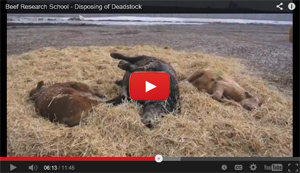How to Dispose of Cattle Mortalities: New Video
How best to dispose of dead cattle is an important question. Some methods are better than others at controlling the spread of disease and preventing contamination of air or ground water. After the advent of BSE in Canada, disposal through traditional channels such as rendering has become more expensive, and in some cases less available.
This episode of the Beef Research School features Dr. Kim Stanford, a researcher with Alberta Agriculture and Rural Development. The pros and cons of various alternatives for disposal of cattle mortalities are explained to help you decide which method might work best on your operation. Dr. Stanford also explains how to start composting dead cattle any time of year.
Because regulations differ across provinces, check local regulations before adopting a particular method.
See the video here.
Stay tuned for upcoming episodes of the Beef Research School, which will soon discuss the beef care code and genetic selection to improve carcass quality. Past episodes covered rangeland health assessment, mineral supplementation, and vaccination programs. More information on the Beef Research School.
Learn more
- Livestock Mortality Management (Disposal) (Alberta Agriculture and Rural Development)
- Enhanced Animal Health Protection from BSE: Requirements for Disposing of Cattle Material (Canadian Food Inspection Agency)
- Handling Deadstock Report (Alberta Beef Producers)
Rendering
- In Alberta and Saskatchewan: West Coast Reductions
- In Ontario: Licensed dead stock operators/removal
Burial
- Livestock Mortality Burial Techniques (Alberta Agriculture and Rural Development)
Incineration
- Carcass disposal: A comprehensive Review. Chapter 10: Incineration (National Agricultural Biosecurity Center Consortium)
Composting
- Composting Animal Mortalities: A Producer’s Guide (Saskatchewan Ministry of Agriculture)
- On-Farm Composting of Large Animal Mortalities (Washington State University Extension)
- Video: Biocontained carcass composting for control of infectious disease outbreak in livestock.
Reuter, T., Xu, W., Alexander, T.W., Gilroyed, B.H., Inglis, G.D., Larney, F.J., Stanford, K. and McAllister, T.A. J.
Click here to subscribe to the BCRC Blog and receive email notifications when new content is posted.
The sharing or reprinting of BCRC Blog articles is welcome and encouraged. Please provide acknowledgement to the Beef Cattle Research Council, list the website address, www.BeefResearch.ca, and let us know you chose to share the article by emailing us at [email protected].
We welcome your questions, comments and suggestions. Contact us directly or generate public discussion by posting your thoughts below.
